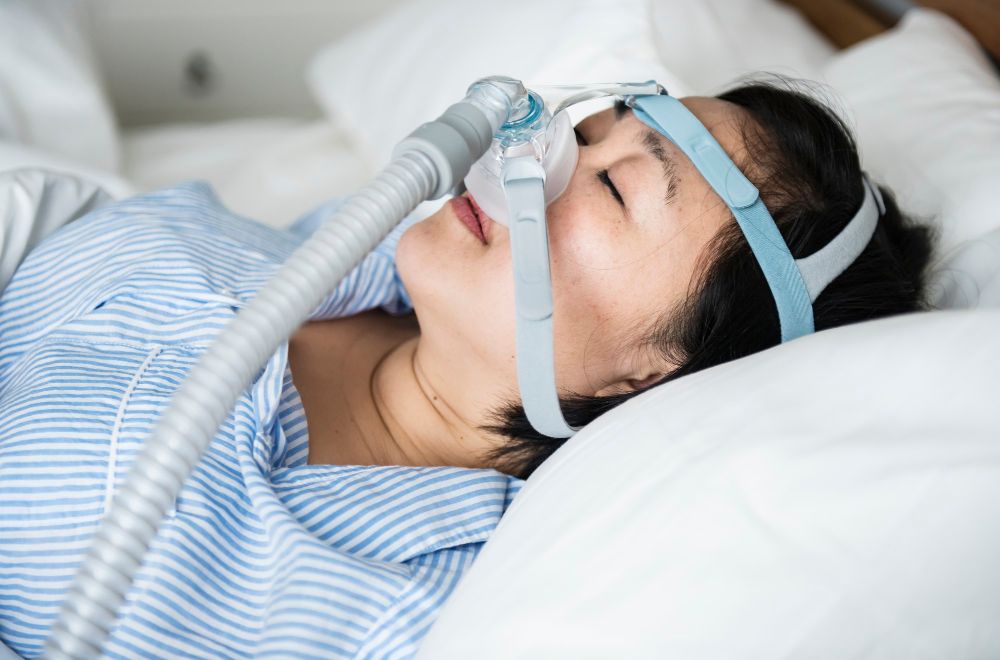To help reduce Sleep apnea-President Biden is using a Continuous Positive Airway Pressure (CPAP) machine at night, as announced by the White House on Wednesday.
Biden originally disclosed his history of sleep apnea in 2008, according to a report from the Associated Press, but this disclosure came after marks were noticed on his face as he departed the White House on Wednesday for a meeting in Chicago.
What is sleep apnea?

The American Press (AP) reported that 30 million Americans had sleep apnea, but just 6 million have received treatment, and 50 million have at least once tried to utilise CPAP machines.
Breathing stops and begins repeatedly while sleeping, a condition known as sleep apnea. The CPAP machine involves wearing a mask during sleep; the machine delivers air pressure into a person’s airway through the mask.
Sleep apnea affects more males than women and can make other medical disorders worse.Biden has abnormal heartbeats, which may be related to his sleep apnea, according to experts, despite the fact that this was stated in his most recent physical in February.
Since sleep apnea can prevent people from having deep, restful sleep, many individuals rely on CPAP machines to assist them in sleeping properly and avoiding daytime drowsiness.
Why is deep sleep important?
Biden has abnormal heartbeats, which may be related to his sleep apnea, according to experts, despite the fact that this was stated in his most recent physical in February.. This leads to the onset of the third stage – slow-wave or deep sleep, where the body truly restores itself at a cellular level, repairing the damage caused by daily wear and tear and consolidating memories for long-term storage.
Sleep apnea affects more men than women, and it can make other health conditions worse.The immune system is strengthened by sleep, especially deep, peaceful sleep, as shown by numerous studies. The body “cleans out the garbage” from the brain during slow-wave sleep, including the beta-amyloid protein, which is connected to the main symptoms and indicators of Alzheimer’s disease.
Because it necessitates a person to experience unbroken and undisturbed sleep, deep sleep is regarded as one of the finest markers of sleep quality.
An Adults should sleep for a continuous period of 7 to 8 hours without any distubance to get the recommended amount of restorative sleep, according to the US Centres for Disease Control and Prevention. Since each sleep cycle lasts around 90 minutes, this requirement is reasonable.
However, those who have sleep apnea can have 30 or more episodes of breathing cessation per hour while they sleep. These episodes are frequently accompanied by snoring, gasping, or the need to wake up in order to recover their breath.
Consistently interrupted sleep makes it difficult to obtain sufficient deep sleep and progress into the final stage known as rapid eye movement (REM) sleep, where dreams occur.
Sleep apnea Has two forms primarly as discussed in detail below:
Obstructive sleep apnea (OSA) is the most common type.
This ailment is brought on by your throat muscles relaxing too much, which blocks your airway. This is a dieses that could happen for a number of reasons, including:
- Excess weight or obesity
- A narrow airway
- A large tongue
- A deviated septum (a crooked septum in the nose)
- Enlarged tonsils or adenoids
- Smoking
- Alcohol use
- Certain medications
OSA is more frequent than central sleep apnea (CSA).
It happens when your brain fails to communicate properly with your breathing muscles, which stops them from operating. Numerous circumstances, such as the following, may cause including:
- Heart disease
- Stroke
- High blood pressure
- Brain tumors
- Certain medications
In some cases, it is seen that the cause of sleep apnea is unknown.
Symptoms of Sleep Apnea
The symptoms of sleep apnea canbe vary from a person to the another person. Some common symptoms include:
- Snoring
- Gasping or choking during sleep
- Restless sleep
- Excessive daytime sleepiness
- Morning headaches
- Trouble concentrating
- Memory problems
- Depression
- Treatment for Sleep
Treatment for Sleep Apnea
If you find that you might have sleep apnea, see a doctor for a diagnosis and treatment. Sleep apnea needs to be treated right away because it can have serious negative effects on one’s health.
There are numerous sleep apnea therapies available, including:
Treatment for OSA that uses continuous positive airway pressure (CPAP) is most common.
A CPAP machine delivers a pressurized air flow through a mask that you wear over your nose and mouth while you sleep. This helps to keep your airway open.
Oral appliances: These appliances can help to keep your airway open by moving your tongue or jaw forward.
Surgery:Some sufferers of sleep apnea may choose to undergo surgery.
To cure sleep apnea, a variety of surgical procedures are available, including:
With uvulopalatopharyngoplasty (UPPP), you might have extra tissue at the back of your throat removed.
Tonsillectomy and adenoidectomy: This surgery removes the tonsils and adenoids.
Maxillomandibular advancement (MMA): This surgery moves the upper jaw and/or lower jaw forward.
Following Your Treatment Plan
It’s crucial to adhere to your doctor’s treatment recommendations if you have sleep apnea in order to enhance the quality of your sleep and lower your chance of developing health issues.
This may include using a CPAP machine, wearing an oral appliance, or having surgery.
Making lifestyle adjustments like decreasing weight, quitting smoking, and avoiding alcohol before bed can all assist to improve sleep apnea.
Living with Sleep Apnea
Although having sleep apnea might be difficult, there are many things you can do to control it. You can enhance your sleep cycle and lower your risk of health issues by following to your treatment plan and changing your lifestyle.
Read more articles here
